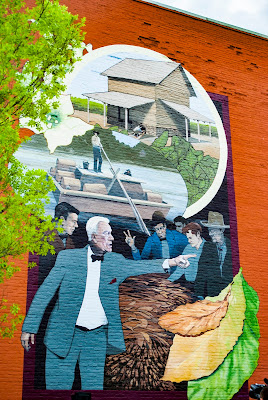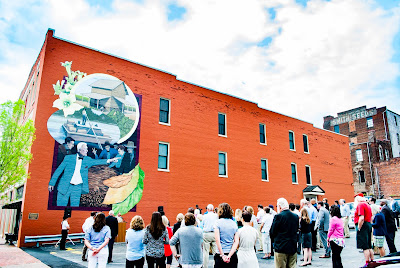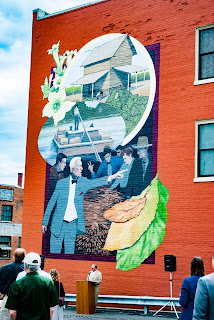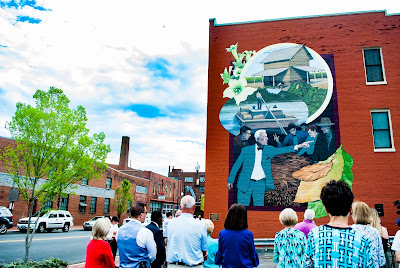Community gardens have sprouted throughout the city and more could be on the way.
There are about a dozen in the city, according to a master garden list from Danville Housing and Development Planning Specialist Jackie Wells.
A lot of cities, including Danville, are looking to revitalize themselves and have more vacant land to grow food, said Annie Martinie, senior program officer with the Danville Regional Foundation.
The DRF has provided grants for groups to start community gardens in the city, and is talking to people who want to start others, Martinie said.
“It’s picking up,” she said.
The DRF provided a $10,000 Make It Happen grant for the Community Market’s garden in 2011. It also provided $10,000 for Camp Grove Baptist Church and about $2,000 for Moffett Memorial Baptist Church to start gardens. There also was a $17,598 investment for a garden under Grace and Main Fellowship in February 2016, Martinie said.
There are more likely to come, Martinie said.
Community gardens are part of a local food trend in which people know where their food comes from and they want it free of pesticides and chemicals, Martinie said.
Also, they enable community members to come together to grow food and eat healthier, she said.
“People who live close to community gardens and participate in community gardening eat more fruits and vegetables,” Martinie said.
The garden at the Community Market on Craghead Street has 15 plots, and provides residents the opportunity to plant their own produce, get in touch with nature and teach their children about gardening, said Kenny Porzio, program coordinator with the Crossing at the Dan.
“Most of them live in the River District,” Porzio said.
It’s convenient for them to walk over, plant, harvest, and go back to their apartments, he said.
Tomatoes and greens are the primary crops, Porzio said. Danville Parks and Recreation funds the garden, maintains it and helps clean it up. Porzio oversees the administration of the plots.
The garden started in 2011 and has an application process every March for those interested. Applicants are selected through a lottery system and assigned plots, Porzio said.
Like farmers markets, community gardens let residents get fresh local food and know where it’s coming from, Porzio said.
Grace and Main Urban Farm — under Grace and Main Fellowship — has at least 20 beds for people to grow food at Moffett Street. Habitat for Humanity donated the land to the fellowship in 2014.
About 60 percent of space is reserved for the community to grow food — including that for the 70 community meals a year the fellowship hosts — or to be given away to the needy, said Joshua Hearne, director of Grace and Main Fellowship.
The other 40 percent is for those who have their own small gardens, Hearne said.
Everything is chemical-free, sustainable and inexpensive, he said.
“They can come and garden with us for a few seasons and if they’re ready to start their own gardens elsewhere, we’ll help them out,” Hearne said.
The space at Grace and Main Urban Farm is about 1.4 acres, with food grown on about 3/4 of an acre, he said. The farm has fruit trees and herbs and grows a plethora of vegetables including tomatoes, squash, zucchini, peppers, cucumber, watermelons, onions, potatoes, carrots, turnips, beets, green beans, October beans and a variety of greens.
A leadership team oversees the gardens — some have gardening and farming experience and others have overcome homelessness, Hearne said. The organization works with those experiencing poverty, addiction, hunger, homelessness and other injustices, he said.
The idea for the urban farm started after the fellowship planted six gardens for individuals in the north part of the city. Those gardens were the seed for the urban farm, Hearne said.
Danville Parks and Recreation oversees community gardens at Coates and Stonewall recreation centers. Coates has three raised beds, and Stonewall has two.
Last summer, they grew basil, parsley, tomatoes, squash and zucchini, said Health and Wellness Program Coordinator Danielle Montague.
Parks and recreation provides parents with produce and recipes and teaches the children how to cook with the vegetables, Montague said.
“Sometimes, they will even come up with their own recipes,” she said.
Arugula and bok choy are being grown, as well as more fruit including strawberries, cantaloupe, watermelon, and blueberries, she said.
Wells started and oversees the city’s Lots of Potential community garden program, which works to change vacant and under-used, city-owned property into sites for food production.
The program connects churches and organizations with available plots of land they can apply for.
Some of the vacant lots in the city may not be ideal for development, so they could be used temporarily for gardening until a developer comes along to buy the property, Wells said.
“If there is an interested developer wanting to build homes or apartments on those lots, they would still be able to do that, but in the meantime, why not have some useful purpose for the land?” Wells said.
The gardens would be removed if a developer decides to build on the property, she said.
Another community garden could be coming to the corner of Worsham and Wagner streets.
The Rev. Tommy Crews, of Right Touch Christian Church, plans to operate a community garden in partnership with the Lots of Potential program.
The Danville Planning Commission voted April 10 to recommend that City Council approve the plans.
Crews told commissioners during the meeting the garden would be not only for the church, but for the community at large. It would include fruits and vegetables, he said.
The garden would be on two parcels totaling about a half-acre at Worsham and Wagner streets. Useable garden space would be about 450 square feet.
Right Touch Christian Church would license the parcels from the city for up to a year, renewable at the end of each term.
It would increase “access to fresh foods in an area where there are few health food options for residents,” Wells said.
“There is increased awareness of what are commonly called ‘food deserts’ — or areas where nutritious food is difficult to obtain due to availability, distance, affordability or some other factor and the effect that these areas have on low- and moderate-income families, including increased health risks,” Wells said during an interview earlier this month.
Community gardens are one way to tackle that issue, she said.
“I’m excited that this local food movement is really taking off and people are interested in growing their own food,” Martinie said.






